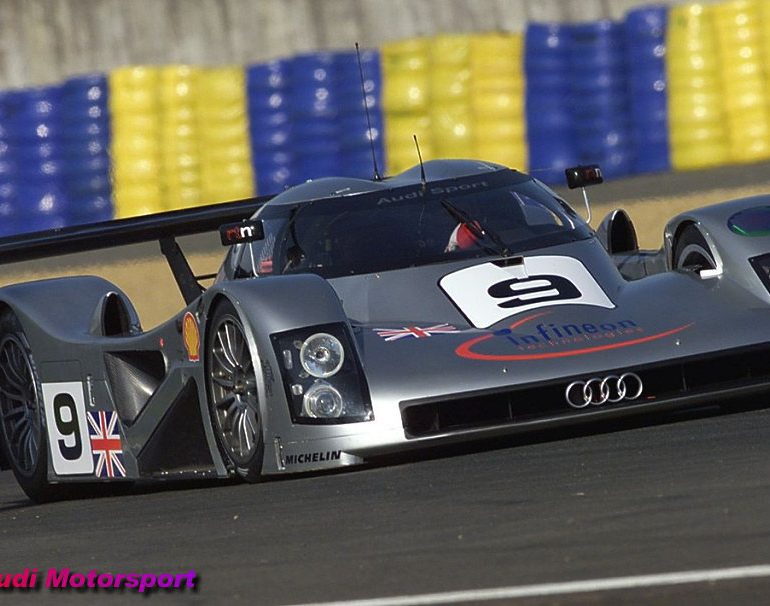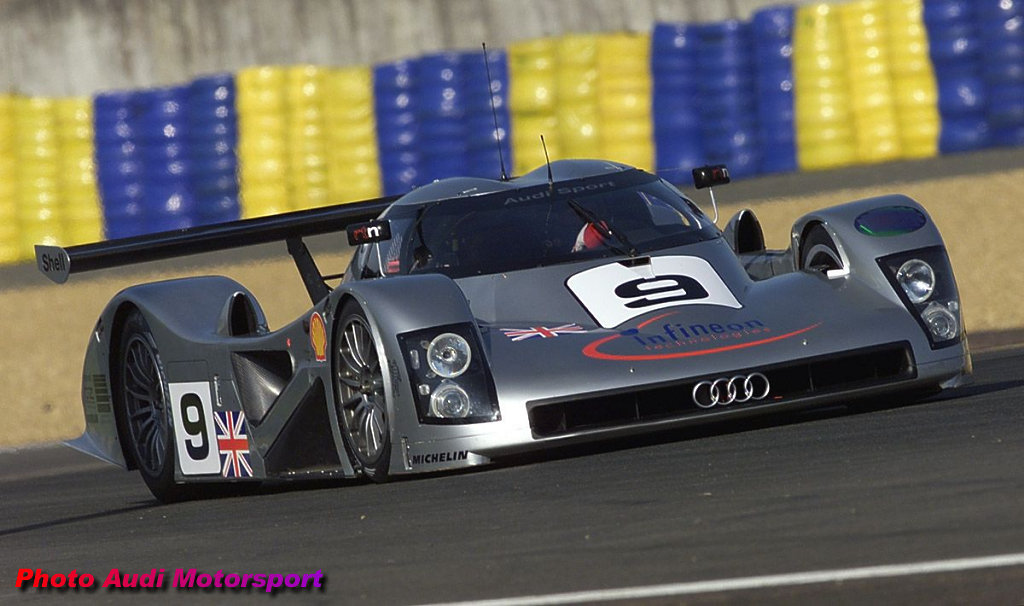1998→1999 Audi R8C
The 1999 Audi R8 racing car heralded a new chapter in Audi’s lengthy and successful history of motorsport. Following notable triumphs in rallying, in the USA and in touring car racing, Audi made its first outing in the Le Mans 24-Hour Race in 1999. Audi thus took on one of the biggest challenges in the world of motor sport and by finishing third and fourth on its debut, laid the foundations for a successful period in sportscar racing.
Two versions of the Audi R8 were created for 1999 – the open R8R (roadster) and the closed R8C (coupé). The advantage of the closed R8C, thanks to its good drag coefficient, was its higher, staightline top speed. On the other hand, the rules allowed the “open top” R8R to be fitted with wider tyres. This meant less tyre wear, as a result of which fewer tyre changes were needed during the course of the race.
Whereas the Audi Sport Joest Racing prepared and raced R8R underwent intensive testing for several months prior to the 1999 Le Mans race – including posting third and fifth places in the Sebring 12 hour race three months before Le Mans – the Audi Sport UK run Audi R8C only rolled out for the first time a few weeks before the obligatory Le Mans pre-qualifier in May at a cold and deserted Snetterton racetrack.
Both versions of the R8 had a carbon fibre monocoque, and the entire body was likewise of lightweight but very strong Kevlar. Audi engaged the Italian specialist Fondmetal as its technology partner for the aerodynamics, which are vitally important in Le Mans. The chassis of the R8C was developed in conjunction with Audi’s British subsidiary rtn (racing technology norfolk) based at Hingham near Norwich.
The 1999 Audi R8 was powered by a new Audi V8 turbo engine with a displacement of 3.6 litres. With the air-flow restriction specified in the regulations, the engine developed over 550 bhp. The longitudinally installed six-speed gearbox with sequential selection was another new development.
The decision to develop the Audi R8 began in autumn 1997. Almost exactly one year later, Audi Sport launched a comprehensive testing and development programme which resulted in the version II R8R, incorporating many in-detail improvements.
After its successful test in the Sebring 12-Hour race in America in March 1999, further intensive test runs took place before Le Mans prequalifying. The two R8Rs were entered at Le Mans by Audi Sport Team Joest, already four time Le Mans winners, with the two R8Cs entered by Audi Sport UK, the Buckingham-based facility that had successfully operated Audi’s British Touring Car programme during 1996-98.
In June 1999, Audi scored impressive results on the German manufacturer’s début at Le Mans. The two Audi R8Rs finished third and fourth. Audi Chief Executive, Dr Franz-Josef Paefgen, remarked: “This result is better than we expected and we will be back next year.”
Seldom before had there been a Le Mans 24 Hour race so strong in manufacturer support and constantly exciting. Only half of the 46 cars which started reached the finishing line after almost 5,000 kilometres and watched by a crowd in excess of 200,000.
Audi’s Head of Sport, Dr Wolfgang Ullrich, was delighted the “open” Audi R8Rs had stood up to the challenge. He said: “For a Le Mans newcomer this is a very good result.”
The two Audi R8Rs were among the top-10 from the start and were able to improve with consistent lap times. At the mid-way point, the no.8 Audi was third, on the same lap of the eventual winning car.
In the early morning hours, however, Frank Biela/Emanuele Pirro/Didier Theys lost precious time due to an unscheduled brake disc change. Later the car had an exhaust pipe replaced. Audi’s former British Touring Car Champion Biela, who was named “Rookie of Le Mans” after qualifying on Thursday, said: “Apart from two small problems, the car was perfect.”
Confirming Audi’s impressive maiden Le Mans performance was the similar R8R of Michele Alboreto/Rinaldo Capello/Laurent Aiello in fourth place. The Audi R8Cs did not finish the race due to transmission problems. But the sleek silver machines, were still able to show their potential with some fast race laps.
Gearbox problems restricted both cars to a small number of laps in official qualifying on Wednesday and Thursday evenings. The R8C of Andy Wallace, James Weaver, and Perry McCarthy lined-up in 20th on Saturday afternoon with the similar Audi of Stefan Johansson, Stéphane Ortelli and Christian Abt in 23rd.
But in the race, the Wallace/Weaver/McCarthy car soon encountered gearbox problems necessitating the first of three gearbox changes restricting their progress to a highest 22nd position before it retired with eight hours remaining. The “sister” R8C managed 19th place before a gearbox fault side-lined the car out on the 13km track after four hours.
Story by Audi Motorsport
In Detail
| submitted by | anonymous |
| type | Racing Car |
| production years | 1998 – 1999 |
| built at | Germany |
| production | 2 |
| engine | Audi 3.6 litre twin-turbocharged V8 engine |
| power | 450 kw / 603.4 bhp |
| top speed | ~350 kph / 217.35 mph |





